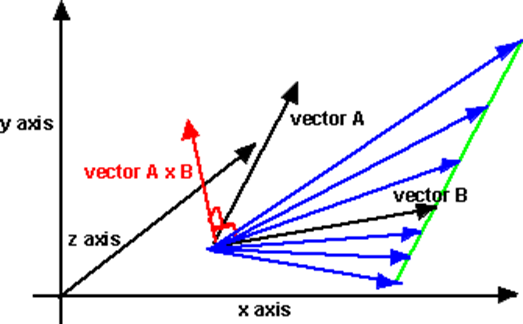The simple observation that vector product is represented by a vector as long as an area warns us that we are not dealing with a mathematically well-founded concept.
Alike the scalar product, also the vector product is not invertible: the mere knowledge of one of the two vectors and the resulting product does not allow us to uniquely trace back the second vector.
Indeed, if we represent two vectors ![]() and
and ![]() and their vector product, we realize that we can identify infinite vectors of different length and direction that leave unchanged the quantity
and their vector product, we realize that we can identify infinite vectors of different length and direction that leave unchanged the quantity ![]()
These possible vectors define a line (in green).

And again: the vector product works only in 3D (requiring the third dimension for the resulting vector). In higher dimensions it is not even defined because there are infinite vectors perpendicular to a given plane.
Another disadvantage: the vector product is not associative and does not have a neutral element, in fact there is no vector ![]() so that
so that ![]()
Then there are some reflections:
Why on earth introduce a vector perpendicular to the plane identified by the two factors?
Why is the right-hand rule necessary? Does Nature somehow prefer right-handed reference systems over left-handed ones? Yet we know that physics is totally symmetrical, apart from a very special case !
The calculation of the vector product knowing vectors’ components is easily obtained by setting the following matrix and calculating its determinant:

to simplify, we say that the two vectors lie in the plane ![]() and therefore the only non-null component will be the
and therefore the only non-null component will be the ![]() -th and the coefficients will be in mixed form with alternating signs:
-th and the coefficients will be in mixed form with alternating signs:
![]()
If, on the other hand, the two vectors to be multiplied do not lie in the ![]() plane, then the complete expression of their vector product will be:
plane, then the complete expression of their vector product will be:
![]()
